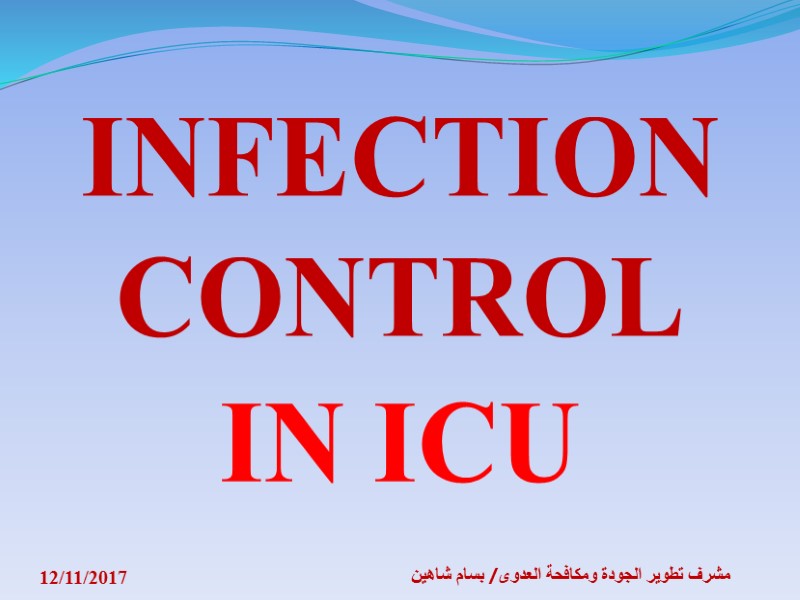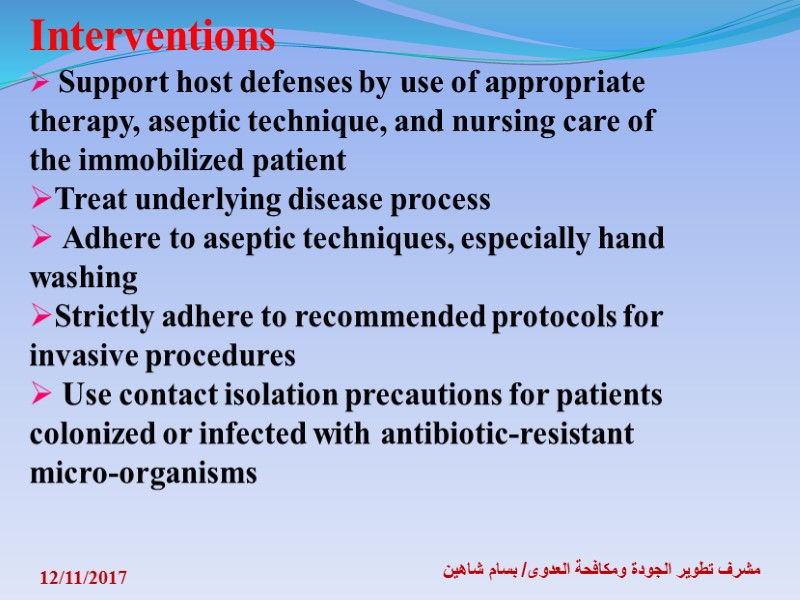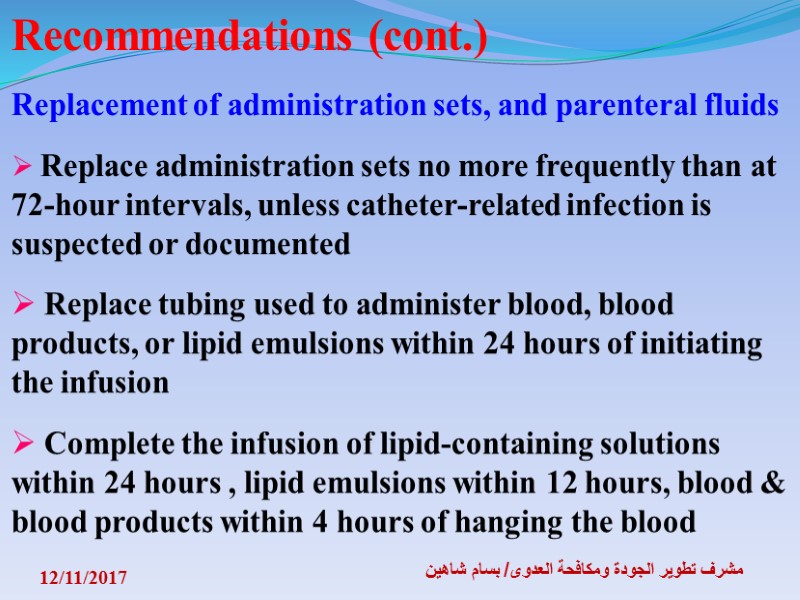INFECTION CONTROL IN ICU 12/11/2017 مشرف تطوير الجودة


INFECTION CONTROL IN ICU 12/11/2017 مشرف تطوير الجودة ومكافحة العدوى/ بسام شاهين

12/11/2017 مشرف تطوير الجودة ومكافحة العدوى/ بسام شاهين Patients in the ICU are at an increased risk of developing nosocomial infection: The severity of the patient’s illness and underlying conditions The length of exposure to invasive devices and procedures The increased contact with health-care personnel The length of the ICU stay The special environmental characteristics of the unit such as space limitations

12/11/2017 مشرف تطوير الجودة ومكافحة العدوى/ بسام شاهين The most frequently encountered problems facing patients and HCWs in the ICU: Nosocomial pneumonia Urinary tract infection Intravascular related infections Surgical site infection Antibiotic resistance

12/11/2017 مشرف تطوير الجودة ومكافحة العدوى/ بسام شاهين Host Characteristics 1. Alterations may be present in the host Defenses Genetic Acquired Secondary to underlying disease 2. Susceptibility to infection is influenced by the severity of underlying illness

12/11/2017 مشرف تطوير الجودة ومكافحة العدوى/ بسام شاهين Host characteristics (cont.) 3. ICU patients become more easily colonized with hospital flora : Patients in the ICU are frequently colonized with hospital flora, which are more likely to be resistant to antibiotics Patients may be exposed to increased numbers of microorganisms from the frequent use and long duration of invasive devices.

12/11/2017 مشرف تطوير الجودة ومكافحة العدوى/ بسام شاهين Interventions Support host defenses by use of appropriate therapy, aseptic technique, and nursing care of the immobilized patient Treat underlying disease process Adhere to aseptic techniques, especially hand washing Strictly adhere to recommended protocols for invasive procedures Use contact isolation precautions for patients colonized or infected with antibiotic-resistant micro-organisms

12/11/2017 مشرف تطوير الجودة ومكافحة العدوى/ بسام شاهين Therapeutic Measures 1-Medical devices Intravascular devices and lines Respiratory support and devices Urinary Catheters

12/11/2017 مشرف تطوير الجودة ومكافحة العدوى/ بسام شاهين Intravascular devices and lines Risk multiple invasive lines new portals of entry. performed in a concentrated time period and/or under emergency conditions lipid emulsions are excellent media for the growth of microorganisms.

12/11/2017 مشرف تطوير الجودة ومكافحة العدوى/ بسام شاهين Recommendations for Placement of Intravascular Catheters Health-care worker education and training Aseptic technique during catheter insertion and care

12/11/2017 مشرف تطوير الجودة ومكافحة العدوى/ بسام شاهين Do proper hand Hygiene Wearing Gloves Select insertion site with the lowest risk Do not routinely use arterial or venous cut down procedures as a method to insert catheters Disinfect clean skin with an appropriate antiseptic Allow the antiseptic to remain on the insertion site and to air dry before catheter insertion.

12/11/2017 مشرف تطوير الجودة ومكافحة العدوى/ بسام شاهين Use either sterile gauze or sterile, transparent, semi permeable dressing to cover the catheter site. Record the operator, date, and time of catheter insertion Monitor the catheter sites visually or by palpation

12/11/2017 مشرف تطوير الجودة ومكافحة العدوى/ بسام شاهين Recommendations (cont.) Selection and replacement of intravascular catheters: Remove any intravascular catheter that is no longer essential Replace peripheral venous catheters . every 72--96 hours in adults to prevent phlebitis When adherence to aseptic technique cannot be ensured (i.e., during a medical emergency), replace all catheters as soon as possible and after no longer than 24 hours Replace all CVCs if CRBSI is suspected.

12/11/2017 مشرف تطوير الجودة ومكافحة العدوى/ بسام شاهين Recommendations (cont.) Replacement of administration sets, and parenteral fluids Replace administration sets no more frequently than at 72-hour intervals, unless catheter-related infection is suspected or documented Replace tubing used to administer blood, blood products, or lipid emulsions within 24 hours of initiating the infusion Complete the infusion of lipid-containing solutions within 24 hours , lipid emulsions within 12 hours, blood & blood products within 4 hours of hanging the blood

12/11/2017 مشرف تطوير الجودة ومكافحة العدوى/ بسام شاهين Preparation and quality control of IV admixtures Administer all parenteral fluids using aseptic technique. Do not use any container of parenteral fluid that has visible turbidity, leaks, cracks, or particulate matter or if the manufacturer's expiration date has passed. Use single-dose vials for parenteral additives or medications when possible.

12/11/2017 مشرف تطوير الجودة ومكافحة العدوى/ بسام شاهين If multidose vials are used Refrigerate multidose vials after they are opened if recommended by the manufacturer. Cleanse the access diaphragm of multidose vials with 70% alcohol before inserting a device into the vial. Use sterile syringe and needle every time to access a multidose vial and avoid touch contamination of the device before penetrating the access diaphragm.

12/11/2017 مشرف تطوير الجودة ومكافحة العدوى/ بسام شاهين Respiratory Support and Devices Risks Mechanical ventilation bypasses the respiratory tract host defenses Contaminated equipment or solutions provide a mechanism for transfer of microorganisms to a susceptible patient Aerosolization of microorganisms may pose a risk to other patients and Personnel

12/11/2017 مشرف تطوير الجودة ومكافحة العدوى/ بسام شاهين Interventions Prevention of aspiration place patient in semi-recumbent position. Preservation of gastric acidity use non alkalinizing gastric cyto protective agent on patients at risk for stress bleeding. Nasal prongs or mask: Change between patients. If masks are reusable, wash thoroughly, dry and wipe with 70% alcohol.

12/11/2017 مشرف تطوير الجودة ومكافحة العدوى/ بسام شاهين 4.Nasogastric-tube : Routinely verify appropriate tube placement. Place patient in semirecumbent position. 5.Endotracheal tubes: They may be recycled after through cleaning and autoclaving. Disposable ones are available but are more expensive. 6.Humidifiers and Nebulizers : Use only sterile water and fluids and dispense them aseptically. If multi-dose medication vials are used, then handle, dispense and store correctly Between treatment on the same patient, disinfect, rinse with sterile water and air dry medication nebulizers.

12/11/2017 مشرف تطوير الجودة ومكافحة العدوى/ بسام شاهين 7.Ventilator circuits: Disposable tubes don not routinely need to be changed for a single patient unless it becomes contaminated or malfunctions. Multiple-use tubes must be heat disinfected for at least 76oC for 30 min., or sterilized between patient. A ventilated patient may use the same circuit for 4-5 days before reprocessing

12/11/2017 مشرف تطوير الجودة ومكافحة العدوى/ بسام شاهين 8.Endotracheal suction catheters: Disposable suction catheters may be used for up to 24 hours on the same patient, provided that it is stored properly and does not become contaminated. The water used for flushing the catheter after each suction must be sterile and changed every time. 9.Suction and drainage bottles: Non disposable bottles must be changed every 24 hours (or sooner if full). The contents are emptied down the toilet and it must be washed and sterilized. The recyclable connector tubing should be cleaned thoroughly and sterilized.

12/11/2017 مشرف تطوير الجودة ومكافحة العدوى/ بسام شاهين 10.Ambu-bags: They are extremely difficult to disinfect and become contaminated very quickly Heat is the most reliable method of disinfection. Glutaraldehyde can also be used but the bag must be rinsed thoroughly in sterile water.

12/11/2017 مشرف تطوير الجودة ومكافحة العدوى/ بسام شاهين Protection of staff and patients by use of appropriate: Isolation precautions Personal protective equipment.

12/11/2017 مشرف تطوير الجودة ومكافحة العدوى/ بسام شاهين Irrigation Solutions Risks Opened bottles of water or other solutions that may be used for irrigation or to fill reservoirs of respiratory therapy equipment remain at the bedside, these opened bottles may become contaminated and serve as a reservoir of microorganisms. Interventions Date all bottles of solutions; discard unused fluid at least every 24 hours.

12/11/2017 مشرف تطوير الجودة ومكافحة العدوى/ بسام شاهين Guideline for Prevention of atheterassociated Urinary Tract Infections Educate personnel in correct techniques of catheter insertion and care. Catheterize only when necessary. Emphasize hand-washing and aseptic technique Secure catheter properly. Maintain closed sterile drainage. Obtain urine samples aseptically. Maintain unobstructed urine flow.

12/11/2017 مشرف تطوير الجودة ومكافحة العدوى/ بسام شاهين Wash hands. Don clean gloves. Cleanse perineum with washcloth if needed. Remove gloves and perform antiseptic hand washing after perineal cleansing. Don sterile gloves. Drape the patient

Thank you 12/11/2017 مشرف تطوير الجودة ومكافحة العدوى/ بسام شاهين
31492-icp_in_icu.ppt
- Количество слайдов: 26

